Supervised machine learning
Supervised learning means the machine learns from labelled examples—just like students learning from a teacher who shows them the right answers.
Supervised machine learning is when you teach a computer using examples where you already know the correct answers.
🎓 Think of it like this:
It's like teaching a child with flashcards.
-
You show a picture of an apple and say, "This is an apple."
-
You show a picture of a banana and say, "This is a banana."
After seeing many examples, the child learns to recognize apples and bananas on their own.
🧪 In machine learning terms:
-
The input is the data (like the picture or a sentence).
-
The output (label) is the correct answer (like "apple" or "banana").
-
The model learns the relationship between the input and the label.
-
Later, you can give it new data, and it will try to predict the correct answer.
Here are some real-world examples of supervised machine learning, organized by domain, with brief explanations:
🔐 1. Spam Email Detection
-
Input (Features): Email content, sender address, subject line.
-
Output (Label): Spam or Not Spam.
-
Algorithm Examples: Naive Bayes, Logistic Regression.
-
Use Case: Gmail, Outlook, and other email services use this to filter junk mail.
🏦 2. Credit Risk Assessment
-
Input: Age, income, employment status, credit history.
-
Output: Loan Default Risk (High/Low) or Credit Score.
-
Algorithm Examples: Decision Trees, Random Forest, XGBoost.
-
Use Case: Banks use this to approve or reject loan applications.
🛍️ 3. Product Recommendation
-
Input: User's past purchases, browsing history.
-
Output: Probability of purchasing a product (Yes/No).
-
Algorithm Examples: Support Vector Machines (SVM), Logistic Regression.
-
Use Case: Amazon, Netflix, Flipkart, and other platforms recommend items.
🎓 4. Student Performance Prediction
-
Input: Attendance, assignment scores, participation.
-
Output: Final Grade or Pass/Fail.
-
Algorithm Examples: Linear Regression, K-Nearest Neighbors (KNN).
-
Use Case: EdTech platforms predict learner outcomes and personalize content.
🏥 5. Disease Diagnosis
-
Input: Symptoms, blood test results, medical history.
-
Output: Disease classification (e.g., diabetes, cancer, etc.).
-
Algorithm Examples: SVM, Neural Networks, Logistic Regression.
-
Use Case: Medical diagnostic systems and predictive healthcare.
🛣️ 6. Traffic Sign Recognition (Computer Vision)
-
Input: Image pixels of a road sign.
-
Output: Sign category (e.g., Stop, Yield, Speed Limit).
-
Algorithm Examples: Convolutional Neural Networks (CNNs).
-
Use Case: Used in self-driving cars for decision-making.
🧠 7. Sentiment Analysis
-
Input: Customer reviews, tweets, or feedback.
-
Output: Sentiment label (Positive, Negative, Neutral).
-
Algorithm Examples: Naive Bayes, LSTM (for sequential data).
-
Use Case: Brands monitor public sentiment using social media analytics tools.
🎯 8. Image Classification
-
Input: Raw image data.
-
Output: Image label (e.g., Cat, Dog, Car, etc.).
-
Algorithm Examples: CNNs, Transfer Learning with ResNet or VGG.
-
Use Case: Facebook's photo tagging, Instagram content moderation.
📦 9. Inventory Demand Forecasting
-
Input: Historical sales, seasonality, promotions.
-
Output: Predicted units needed.
-
Algorithm Examples: Linear Regression, Time Series Models with supervised extensions.
-
Use Case: Retail chains optimize stock to reduce overstock or shortages.
🗣️ 10. Speech Emotion Recognition
-
Input: Audio recordings with extracted features (pitch, tone, etc.).
-
Output: Emotion label (Happy, Angry, Sad, etc.).
-
Algorithm Examples: Recurrent Neural Networks (RNN), SVM.
-
Use Case: Call centers analyze customer tone to improve service.
Here is a detailed overview of the most common supervised learning techniques:
1. Linear Regression
-
Type: Regression
-
Use Case: Predicting continuous values (e.g., housing prices).
-
How it works: Assumes a linear relationship between input variables (X) and the output (y).
-
Formula:
y=β0+β1x1+β2x2+⋯+βnxn
2. Logistic Regression
-
Type: Classification
-
Use Case: Binary or multi-class classification (e.g., spam detection).
-
How it works: Models the probability that a given input belongs to a particular class using the logistic (sigmoid) function.
3. Decision Trees
-
Type: Classification/Regression
-
Use Case: Fraud detection, credit scoring, etc.
-
How it works: Splits the data into subsets based on feature values using conditions (like yes/no questions), forming a tree structure.
4. Random Forest
-
Type: Classification/Regression
-
Use Case: High-accuracy tasks with large datasets.
-
How it works: Ensemble of multiple decision trees; each tree is trained on a random subset of data and features. Final prediction is made by majority vote or averaging.
5. Support Vector Machines (SVM)
-
Type: Classification/Regression
-
Use Case: Image classification, bioinformatics.
-
How it works: Finds the optimal hyperplane that separates classes with maximum margin. Can handle non-linear data using kernel tricks.
6. K-Nearest Neighbors (K-NN)
-
Type: Classification/Regression
-
Use Case: Pattern recognition, recommendation systems.
-
How it works: Stores all training data; a new input is classified based on the majority class among its k-nearest neighbors.
7. Naïve Bayes
-
Type: Classification
-
Use Case: Text classification, spam filtering.
-
How it works: Applies Bayes' Theorem with strong (naïve) independence assumptions between features.
8. Gradient Boosting Machines (GBM) / XGBoost / LightGBM / CatBoost
-
Type: Classification/Regression
-
Use Case: Kaggle competitions, production-level machine learning.
-
How it works: Sequentially builds models that correct the errors of previous models. Uses decision trees as base learners.
9. Neural Networks (Shallow and Deep)
-
Type: Classification/Regression
-
Use Case: Complex problems like image recognition, natural language processing.
-
How it works: Composed of layers of neurons that transform input data through learned weights and activation functions.
Supervised Machine Learning Technique- Decision Tree
🌳 What is a Decision Tree?
Imagine you're playing a game of 20 Questions, where you ask yes/no questions to guess something. A Decision Tree works in a similar way. It's like a flowchart that helps make a decision step by step by asking questions.
🧠 Simple Example:
Let's say you're trying to decide whether to play outside or not. You might ask yourself:
-
Is it raining?
-
If yes, then → Don't play outside
-
If no, then go to next question
-
-
Is it too hot?
-
If yes, then → Don't play outside
-
If no, then → Yes, play outside!
-
Each question is like a branch in the tree, and each final answer is a leaf.
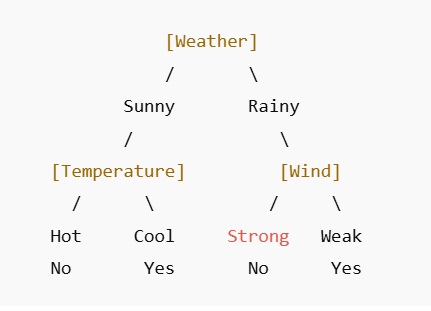
Sample Decision:
Let's say:
-
It's Sunny
-
Temperature is Cool
Path:
-
Weather = Sunny → go left
-
Temperature = Cool → go right
-
Result: Yes, play outside
💻 Should You Buy a Laptop?
We'll use 3 simple features:
-
Budget (High, Low)
-
Purpose (Gaming, Office)
-
Brand Trust (Trusted, Unknown)
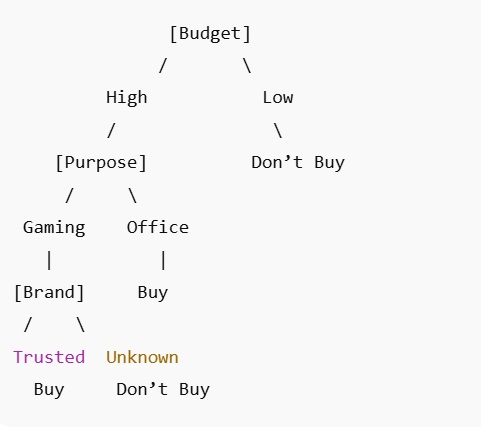
✅ Example Decision:
Let's say:
-
Budget: High
-
Purpose: Gaming
-
Brand: Trusted
Path:
-
Budget = High → go left
-
Purpose = Gaming → go left
-
Brand = Trusted → go left
-
✅ Result: Buy the laptop
🌳 Goal: Predict if a Person Will Buy Ice Cream
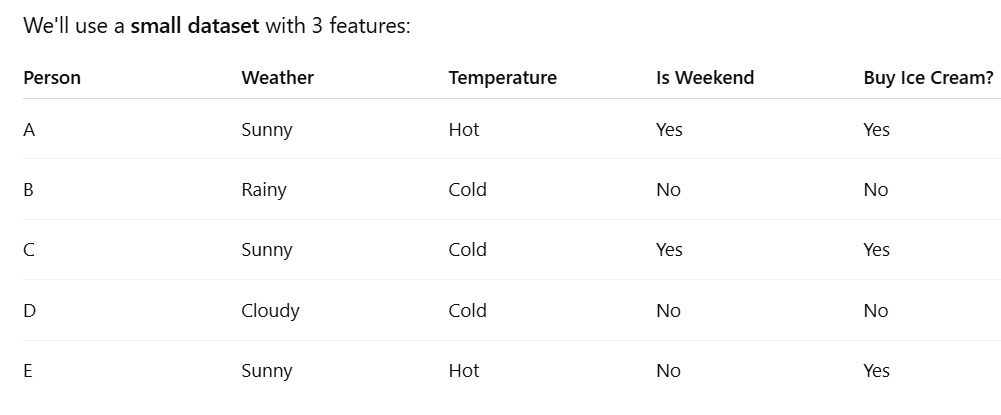
🧠 Creating a decision tree with this data
✅ Step 1: Look at the Target
We want to predict "Buy Ice Cream?" based on other information.
✅ Step 2: Pick the Best Feature to Split
We ask:
Which feature (Weather, Temperature, or Is Weekend) best separates Yes/No?
Let's try Weather first:
-
When Weather = Sunny → A, C, E → All "Yes"
-
When Weather = Rainy or Cloudy → B, D → Both "No"
💡 Perfect split! Weather clearly separates the Yes and No groups.
So we make Weather our first question.
Step 3: Draw the Decision Tree
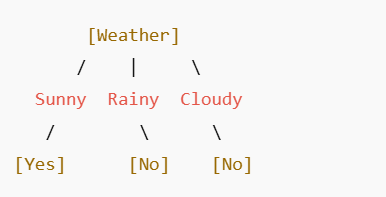
Done! Our tree says:
-
If Weather = Sunny → Yes
-
If Weather = Rainy or Cloudy → No
✅ Test It:
New person:
-
Weather = Sunny
-
Temperature = Cold
-
Is Weekend = No
Prediction: → The tree says "Sunny" → So, Yes, they'll buy ice cream!
🌲Supervised Machine Learning Technique - Random Forest
A Random Forest is like a team of decision trees that work together to make better decisions. Imagine asking not just one friend for advice, but a group of friends and then taking a vote. That's how a Random Forest works!
🤔 Why use Random Forest instead of just one tree?
-
Decision trees can sometimes make mistakes or overfit (learn too much from training data).
-
A random forest builds many trees and combines their results to reduce error and increase accuracy.
🔍 How It Works (Layman Terms):
-
You create lots of decision trees.
-
Each tree sees a random part of the data (this is called bootstrapping).
-
Each tree also looks at only a random set of features when making splits.
-
Each tree gives a prediction.
-
The forest takes a vote:
-
For classification: it picks the class with majority vote.
-
For regression: it takes the average prediction.
-
📦 Real-Life Example:
Should a bank approve a loan?
-
Instead of relying on one decision tree, the bank builds 100 decision trees, each looking at slightly different customer data (like income, job history, credit score, etc.).
-
Each tree makes a yes/no decision.
-
The majority vote (e.g., 75 say YES, 25 say NO) is the final decision: Approve the loan.
✅ Benefits:
-
Very accurate and robust.
-
Works well with both classification and regression tasks.
-
Handles missing data and noisy datasets.
⚠️ Downsides:
-
Slower than a single tree (more trees = more time).
-
Less interpretable (you can't easily draw the whole forest).
Here's a simple example of Random Forest in action—explained in an easy-to-understand way
💡 Scenario: Predict if a person will buy a mobile phone
We have a small dataset with these features:
-
Age
-
Income
-
Likes Tech
-
Will Buy Phone? (Target: Yes/No)
Sample Data
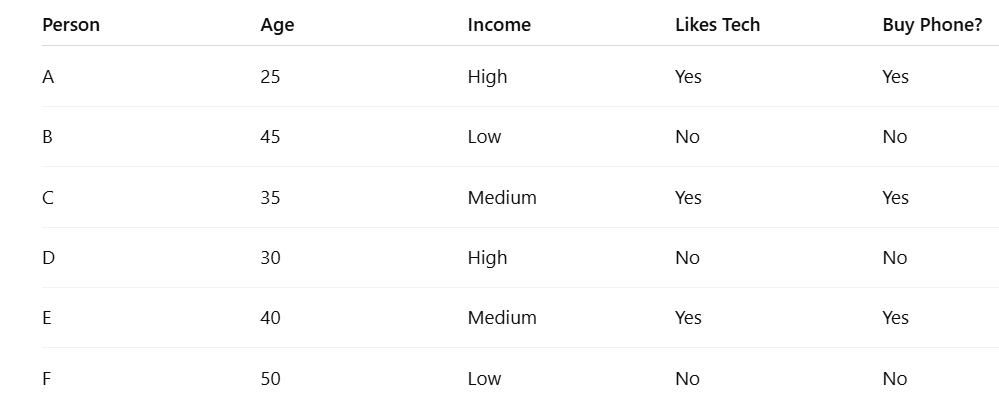
🌲 How Random Forest Works:
Let's say we build 3 decision trees in the forest.
📌 Tree 1 might learn:
-
If Age < 40 AND Likes Tech → Yes
-
Else → No
📌 Tree 2 might learn:
-
If Income is High → Yes
-
Else → No
📌 Tree 3 might learn:
-
If Likes Tech = Yes → Yes
-
Else → No

🔍 Each Tree Predicts:
-
Tree 1: Age < 40 & Likes Tech → Yes
-
Tree 2: Income is not High → No
-
Tree 3: Likes Tech = Yes → Yes
🗳️ Final Vote:
-
Yes → 2 trees
-
No → 1 tree
✅ Random Forest Prediction: Yes (buy phone)
